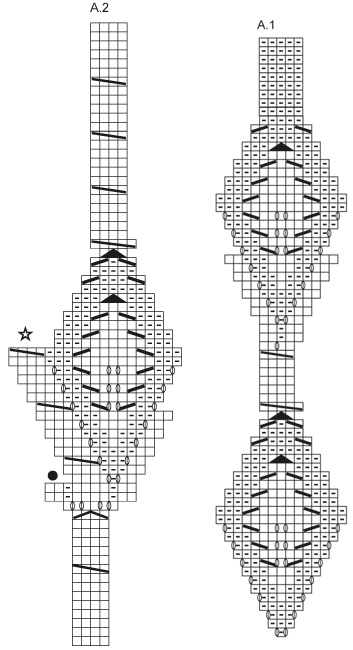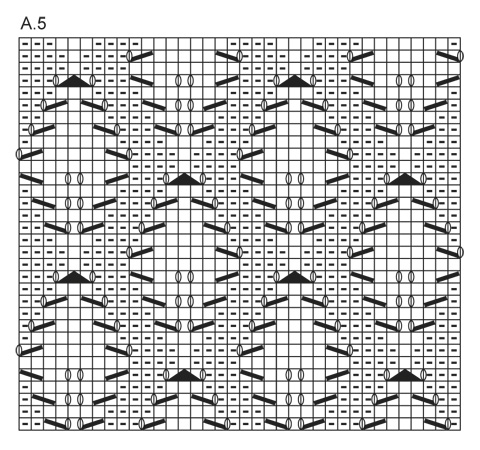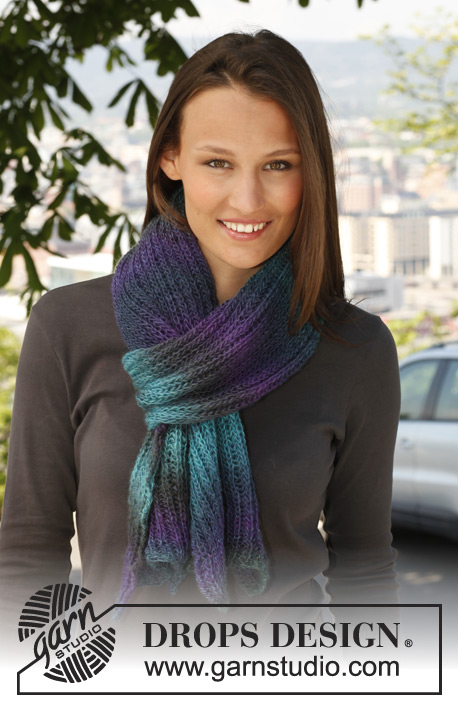Comments / Questions (50)
![]() Dawn wrote:
Dawn wrote:
Can I purchase the written instructions for the hat and neck warmer please
01.02.2024 - 05:55
![]() Maureen Humphries wrote:
Maureen Humphries wrote:
Row 9 on A1 i can not find symbol in explations I read it as - Yarn over needle, Pearl 2 , ?? , yarn over needle, ??, pearl 2, yarn over needle Can you please tell me what happens where my question marks are Thank you
02.02.2022 - 11:12DROPS Design answered:
Hi Maureen, row 9 on A1: 1 YO; P2; K2 tog; 1 YO; K1; 1 YO; slip 1 st as if to K, K 1, psso; P2; 1 YO. Happy knitting!
02.02.2022 - 12:17
![]() Launay wrote:
Launay wrote:
Bonjour, il est noté que les diagrammes A1, A2, A3 et A4 sont à réaliser pour le bonnet. Mais il n'est pas expliqué quand réaliser les diagrammes A3 et A4. pouvez vous me l'expliquer quand réaliser ces diagrammes. Merci d'avance pour votre réponse. Cordialement Muriel
14.11.2021 - 16:58DROPS Design answered:
Bonjour Muriel, retrouvez cette information dans les diagrammes A.1 et A.2 - cf avant-dernier + dernier symbole: on va insérer A.3 après A.2 et A.4 après A.2 (avant A.3). Bon tricot!
15.11.2021 - 08:21
![]() Giorgia wrote:
Giorgia wrote:
Il diagramma A4 inizia al 34° giro di A2? La posizione della stella sembrerebbe indicarne l'inizio al giro 35°, ma se si contano i giri dal 34° giro di A2 occorrono ulteriori 36 giri alla fine del berretto, facendo così terminare contemporaneamente tutti i 4 grafici. (il diagramma A4 infatti si realizza in 36 giri totali )
20.09.2021 - 22:16DROPS Design answered:
Buonasera Giorgia, il diagramma A.4 si lavora sulle 4 maglie indicate dalla stella. Buon lavoro!
22.09.2021 - 18:45
![]() Elena Onorati wrote:
Elena Onorati wrote:
Per lo scalda collo, lavorando coi ferri circolari devo sempre considerare che tutti i ferri sono visti dal diritto del lavoro? E quindi il quadratino bianco è un diritto sui giri dispari ed un rovescio nei giri pari? O posso seguire lo schema così come rappresentato dal n giri di andata e ritorno?
23.06.2021 - 23:17DROPS Design answered:
Buonasera Elena, lavorando in tondo, il quadratino bianco è sempre a diritto. Buon lavoro!
23.06.2021 - 23:45
![]() Paola Pace wrote:
Paola Pace wrote:
Scusate ho compreso l'equivoco, le istruzioni sono giuste: la maglia al dritto accavallata si recupera con la gettata fatta successivamente! Grazie!
27.01.2021 - 14:15
![]() Paola Pace wrote:
Paola Pace wrote:
Basco in lana viola "dancing drops" diagramma A.1 partendo dal basso rigo 10, le due maglie sopra alla diagonale del rigo 9: la diagonale sono 2 maglie insieme quindi al rigo 10 deve stare 1 maglia non 2 al dritto
25.01.2021 - 18:47DROPS Design answered:
Buonasera Paola, il diagramma è corretto, sul ferro 9 vengono lavorate le diminuzioni e aumenti, sul ferro 10 il ferro di ritorno e sul ferro 11 ancora diminuzioni e aumenti. Buon lavoro!
25.01.2021 - 18:57
![]() Paola Pace wrote:
Paola Pace wrote:
Round 9 nella foglia ci sono 2 maglie al dritto insieme (2 quadratini con diagonale ) nel ferro successivo ci dovrebbe essere una sola maglia (round 10 che non è mostrato) invece ci sono ancora 2 maglie al dritto. Che devo fare? Grazie!
25.01.2021 - 04:33DROPS Design answered:
Buonasera Paola, ci può spiegare meglio a quale diagramma fa riferimento? I diagrammi mostrano tutti i ferri del motivo, visti dal diritto del lavoro. Buon lavoro!
25.01.2021 - 18:16
![]() Anna wrote:
Anna wrote:
I'm working on the hat and I'm at R45 from A1. So the row starts with a yarn over, P2, but on the previous row (R44) I have K2. If I start R 45 with an increase the leaf pattern does not align...should I slip the first two stitches or K2, then yarn over and continue R45? Thank you.
28.12.2020 - 22:27DROPS Design answered:
Dear Anna, these K2at the beg of the round will be worked together with the last K2 to make the cable in A.2. You can work these first 2 sts or slip them as you prefer, they will be worked anyway with the cable in A.2 at the end of the round. Happy knitting!
04.01.2021 - 11:30
![]() Verena wrote:
Verena wrote:
Meine Frage betrifft die Mütze. Gemäss dem Bild werden die Umschläge in den Blättern nicht verschränkt abgestrickt, sodass Löcher entstehen. Aber alle anderen Umschläge werden verschränkt abgestrickt, damit keine Löcher entstehen? In den Diagrammen wird die unterschiedlich Bearbeitung der Umschläge nicht ersichtlich, oder übersehe ich hier etwas?
09.10.2018 - 14:28DROPS Design answered:
Liebe Verena, die Umschläge stricken Sie wie im Diagram (= Löcher), wenn Sie die Löcher nur in der Mitte des Blätters möchten, können Sie alle andere verschränkt stricken. Viel Spaß beim stricken!
09.10.2018 - 14:34
Dancing Leaves#dancingleavesset |
||||||||||||||||||||||||||||||||||
 |
 |
|||||||||||||||||||||||||||||||||
Set consists of: Knitted DROPS hat with cables and leaf pattern and knitted neck warmer with leaf pattern in ”Merino Extra Fine”.
DROPS 165-39 |
||||||||||||||||||||||||||||||||||
|
PATTERN: See diagrams A.1 to A.5. A.1 to A.4 applies to hat, A.5 applies to neck warmer. ---------------------------------------------------------- HAT: Work top down, first on double pointed needles and then circular needle when there are enough sts. Cast on 8 sts on double pointed needles size 3.5 mm with Merino Extra Fine. ROUND 1: * K 1, 1 YO *, repeat from *-* 8 times = 16 sts. ROUND 2: K all sts (K YOs twisted to avoid holes). ROUND 3: K 1, * K 1, 1 YO *, repeat from *-* 14 times, K 1 = 30 sts. ROUND 4: K all sts (work YOs twisted). ROUND 5: * Work A.1 (= 1 st), A.2 (= 4 sts) *, repeat from *-* 6 times. Continue pattern like this. When A.1 and A.2 have been worked 1 time vertically, there are 108 sts on round. K 1 round and P 1 round, cast off on next round. Use a needle and thread, baste the hole at the top of the hat. Tighten and fasten. ---------------------------------------------------------- NECK WARMER: Cast on 144 sts on circular needle size 4 mm with Merino Extra Fine. P 1 round, K 1 round, P 1 round, then work A.5 (= 4 repetitions in width). Continue to work until piece measures 30 cm, finish after 5th, 13th, 21st or 29th row. P 1 round, K 1 round and P 1 round, then cast off with K. |
||||||||||||||||||||||||||||||||||
Diagram explanations |
||||||||||||||||||||||||||||||||||
|
||||||||||||||||||||||||||||||||||

|
||||||||||||||||||||||||||||||||||

|
||||||||||||||||||||||||||||||||||

|
||||||||||||||||||||||||||||||||||
Have you finished this pattern?Tag your pictures with #dropspattern #dancingleavesset or submit them to the #dropsfan gallery. Do you need help with this pattern?You'll find 22 tutorial videos, a Comments/Questions area and more by visiting the pattern on garnstudio.com. © 1982-2025 DROPS Design A/S. We reserve all rights. This document, including all its sub-sections, has copyrights. Read more about what you can do with our patterns at the bottom of each pattern on our site. |
||||||||||||||||||||||||||||||||||







































































Post a comment to pattern DROPS 165-39
We would love to hear what you have to say about this pattern!
If you want to leave a question, please make sure you select the correct category in the form below, to speed up the answering process. Required fields are marked *.